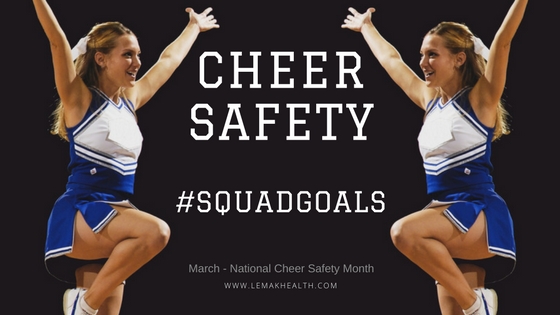National Cheerleading Safety Month | Lemak Health
Along with National Athletic Training Month, March is also Cheerleading Safety Month! Safety is a big concern in all sports and cheerleading is no exception. Cheerleading isn’t as aggressive as high impact sports like football or hockey, but cheerleading has become more competitive, moving from the sideline to center stage.
Because these athletes typically combine both stunting and tumbling into an intense and fast-paced routine, there are many opportunities for accidents and serious injury to arise if the proper precautions aren’t taken. The top cheerleading-related injuries include 53% sprains or strains followed by concussions. More than half of all concussions occurred from stunting (pyramid formations) and tumbling.
Lemak Heath knows safety is vital to the health and performance of our team’s biggest supporters. Our trained physicians and physical therapy partners can help. Our mission at Lemak Health Concussion Clinics is to provide patients (athlete or non-athlete), of any age, with prompt evaluation, proper treatment and medical clearance for sports-related concussions.
Shine the spotlight on cheerleading safety
March Madness often marks the winding down of basketball season and most school cheerleading programs come to an end. Soon tryouts for the next season will take place, giving coaches the opportunity to implement their safety programs for a new team.
Basic Cheer Safety:* Remove all jewelry * Wear athletic shoes * Keep your hair tied back * Always have supervision * Practice on safe surfaces such as mats and padded floors * Have an emergency plan
|
In order to stay out of harm’s way and still perform spectacular stunts, there are a few basic guidelines that must be followed:* Get proper instruction * Always use a spotter * Follow the proper skill progression and technique * Warm-up * Communicate and trust your partners * Don’t ignore injuries
|
Fun Fact:
Cheerleading has been around for a long time, since the late 1800’s in fact, and believe it or not back then it was an all-male sport.
From 1877-1923, it was the men that led the cheers, that helped to support their team.
Cheerleading can be a safe and healthy activity when it is properly supervised.
School Administrators and Coaches, Cheerleaders and Parents, let’s use this month of awareness to make sure we are all doing our part! Administrators, please make sure you have selected a qualified coach to supervise the team and give them sufficient support as athletes with access to an athletic trainer during both sporting events and practices. Make sure your cheerleaders have adequate practice facilities and proper safety equipment.
Coaches should complete the American Association of Cheerleading Coaches and Administrators safety course and make sure that you are following recognized safety rules and practices outlined for your program by the (AACCA, NFHS or USASF). You or someone at practice, such as a coach’s assistant, should be CPR certified and trained in basic first aid. Coaches, develop and practice an emergency plan in the event a serious injury occurs.
Cheerleaders, you too have a responsibility for your own safety. If you feel scared about a particular stunt or tumbling skill, voice your concerns to your squad, your stunting partners, or your coach. Take stunting very seriously, and stay focused on the skill and your part in it, until it is safely completed. Practice good health and fitness habits so you can perform to the best of your ability. Remember, others are relying on you to be at your best during every performance, do not ever dismiss or push through an injury.
Parents are the cheerleaders to the cheerleaders. It is important that when practicing outside of their designated times, that your cheerleader follows the same safety measures as they would with her coach by their side.
“Teaching others the importance of safety in sports can have a tremendous impact, even as big as saving a life.” Larry Lemak, MD
Dr. Larry Lemak of Lemak Health and former CEO of the Sports Medicine and Athletic Related Trauma (SMART) Institute, has devoted his time to treat and care for patients as well as teaching and training other professionals on sports safety. Founding the National Center for Sports Safety in Birmingham, Alabama, Dr. Lemak strives to better the nation’s athletic community through safety and prevention of injuries.
#cheersafety #squadgoals #Results #Recovery #Sportsmedicine #Injuryprevention





